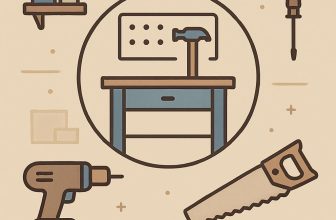
Small shop, big potential-how do you squeeze genius from a few square meters? In woodworking, space is as essential as light and air. A smart layout not only fits more tools; it sharpens safety,boosts flow,and sparks creativity by letting you focus on the cut,not the clutter. This article unlocks practical layouts you can implement in tight rooms, garages, or basements. You'll learn how to zone tasks, pick compact storage, route dust and power efficiently, and adapt layouts to your projects. By the end, you'll have actionable ideas to maximize every inch without sacrificing usability.
Smart Zoning and Flow for a Small Workshop
Smart zoning starts with mapping the workflow from raw material to finished piece. For a small shop,define distinct zones: a cutting and prep area,a machining/assembly zone,a finishing and detailing space,and a dedicated storage zone for both raw materials and finished goods. Keep circulation clear by reserving a main traffic lane along the longest wall and positioning the entry so materials flow through the space without clogging the center.
Arrange tools and benches to mirror the sequence of tasks.place the most frequently used devices within arm's reach of the primary work zone, and use mobile carts to shuttle heavier items as needed. Create a dust collection nook adjacent to cutting and sanding, with a short, direct duct path to minimize dust travel. For finishes, set aside a sealed corner with a small cabinet for solvents and brushes, clearly separated from work zones that generate dust.
| Zone | Primary Function | key Tools | Layout Tip |
|---|---|---|---|
| Cutting/Prep | Material prep, measuring | Saw, rulers, clamps | Near entry; align with workflow |
| Machining/Assembly | Fabrication and assembly | Workbench, vises, power tools | Line up along the longest wall |
| finishing | Sanding, painting, coating | Vent, brushes, rags | Sealed corner with good ventilation |
| Storage & Returns | Raw materials and finished goods | Shelves, bins, labeling | Vertical storage; keep daily items visible |
Beyond static zones, add dynamic flow improvements that adapt to projects.Place a small mobile cart for frequently used consumables near the assembly zone, and mount hooks or panels to keep hand tools within reach without clutter. Designate a flexible area where items can be moved between zones without crossing the main pathways, and ensure the ventilation plan can scale with space as needs evolve.
Practical tips for maintaining flow: mark zones with color-coded tape for routes and aisles, position outlets along bench ends, and implement cable management to keep floors clear. Use modular, mobile stations to reconfigure quickly as project types change, and schedule a short daily tidy-up to reset zones and prevent crossovers. A rapid weekly walk-through helps catch creeping clutter and reinforce the intended workflow.
Build Your Dream Workshop on a Budget →
Vertical Storage strategies to Maximize Space in a Compact Workshop
Vertical storage strategies reclaim valuable floor space in a compact workshop by turning walls into efficient storage workflows. Begin with wall-mounted systems: a sturdy pegboard or modular slatwall for hand tools, and hanging rails for power tools. Place frequently used items at eye level and reserve higher shelves for seasonal gear. Use clear,labeled bins on shelves to keep fasteners organized and easy to locate at a glance.
Maximize ceiling and overhead options to keep the bench area open. Ceiling-mounted racks, pulley hoists, and retractable cord reels can hoist bulky items like cords, drills, or portable vacuums out of the way. ensure secure anchoring into joists with rated hardware, and balance weight evenly across supports. A simple routine is to lower what you need, then return it to its hook when finished. This approach dramatically reduces clutter on the floor.
To visualize common configurations at a glance, review the compact guide below. Tip: tailor each system to your workflow and space constraints, adjusting positions as your toolkit evolves.
| Storage Type | Ideal location | Key Benefit | Notes |
|---|---|---|---|
| Pegboard & Tool Boards | Near workbench | Instant visibility and access | Use sized hooks for each tool |
| Slatwall / Panels | Perimeter walls | Flexible reconfiguration | Combine with bins and baskets |
| Ceiling Hoists & Rails | Above benches or center | Free up floor space | Ensure proper joist anchoring |
| Wall-Mounted Cabinets | Outboard walls | Closed storage and dust protection | Check door clearance |
embed clear labeling and a simple maintenance cadence to keep vertical gains lasting. Create a wall map or legend that marks where every category belongs, run a quick weekly reorganization, and color-code by type (electric, fasteners, measuring tools). Safety comes first: never overload upper racks beyond their rating and keep flammable items away from heat sources.
Build Your Dream Workshop on a Budget →
Flexible Work Surfaces for Efficient Tool Access
Flexible work surfaces transform a compact bench into a dynamic, efficient workspace. Fold-down wings, cantilevered shelves, and rolling carts let you tailor the footprint to the task at hand. Keep frequently used tools within arm's reach by aligning surfaces with the main workflow so you don't waste time searching. Plan for adaptability by designating primary, secondary, and occasional-task zones, and choosing surfaces that can shift without turning the shop into a maze.
Map your projects and assign dedicated surfaces to each stage-prep, assembly, and finishing. Attach quick-access rails,magnets,and small bins along the edge to keep frequently used items visible and accessible. When possible, choose surfaces that fold away or roll out of the way after use to preserve clear floor space. The table below shows practical options at a glance.
| Option | Best For | Key Benefit |
|---|---|---|
| Folding outfeed table | End-of-task prep and measurement | Stows flat to free space |
| rolling work cart with extendable top | Mobile workspace and tool reloading | Moves with you, stable when extended |
| Wall-mounted flip-down desk | Occasional tasks, tight footprint | Zero footprint when folded |
run a simple maintenance routine to keep these surfaces performing: verify that hinges and locks stay snug, wipe down after messy tasks, and label tools for rapid return. Pair each surface with proper lighting and a power strip to avoid chasing cords, and keep dust control in mind to protect delicate finishes. Start with one movable surface and one fold-down option, then layer in additional pieces as the workshop grows.
Build Your Dream Workshop on a budget →
Hidden Storage Solutions to Cut Clutter in a Small shop
Hidden storage can reclaim precious square footage in a compact shop. by embracing vertical surfaces, dual-purpose furniture, and discreet organizers, you keep tools and materials within arm's reach without crowding the floor. The goal is to maintain a clean, efficient workflow where every item has a home – and that home is cleverly tucked away until you need it.
Explore a few proven tactics that blend concealment with accessibility. Install shallow wall cabinets above work benches, install pegboard panels with hidden pockets, and use hinged or lift-top benches that open to reveal bulk storage.Put frequently used bits in labeled, clear bins that slide behind doors or under benches for quick access while keeping the surface clear for project work.
| Idea | Stores | Best Space |
|---|---|---|
| Overhead pegboard with pockets | Screws, drill bits, small parts | wall space above work area |
| Lift-top bench or hinged top | Hand tools, fasteners | Under the worktop |
| Behind-door slim cabinets | Flat items, manuals | Back of doors |
| Rolling cart with concealed compartments | Long items, longer stock | floor-located mobility |
Labeling and accessibility matter as much as concealment. Use transparent containers for quick visual checks, color-code lids by category, and dedicate a small, magnetic strip along the inner door of a cabinet for fast metal bits. Schedule a quarterly declutter to rotate items in hidden spaces so obsolete gear never hides in plain sight. For a cohesive look, keep hidden storage aligned with your workflow zones and maintain a consistent height and depth across modules.
To tailor hidden storage to your space, start with a simple audit: measure each wall, door, and bench length, then map where tools most often land. Anchor wall cabinets at eye level for quick grab-and-go access, and tuck rare or bulky items behind liftable panels that don't interrupt the main work surface. Finish with budget-friendly upgrades like pegboard with removable bins, magnetic strips, and upcycled bin lids to keep the project flow smooth and clutter-free.
Build Your Dream Workshop on a Budget →
Lighting and Power Planning for a Bright and Efficient Workspace
Layered lighting is the backbone of a bright, efficient workspace. Start with even ambient light from ceiling fixtures or wall-mounted panels, then add task lighting at each bench and tool zone, and finish with a touch of accent lighting to reduce glare on polished surfaces. Map your room: where benches, stands, and storage eyes may cast shadows, and place fixtures so your hands stay well lit as you work. The goal is a harmonious brightness across the space,with no dark corners that steal focus or strain the eyes.
maximize efficiency with a daylight-balanced color temperature (approximately 4000-5000K) that renders tool colors accurately and keeps you alert.use extendable task lamps at each station and slim under-shelf LED strips where vertical space is tight.Choose dimmable fixtures or smart switches so you can tune brightness for precision tasks or overnight setup. A few quick checks: verify fixture spacing using the room's length and benches, and aim for at least 30-40 lumens per square foot for general work, closer to 70-100 for fine detail, depending on the task.
Power planning keeps the workflow smooth and safe. Place outlets near each work zone, with dedicated circuits for heavy tools when possible, and reserve a central surge-protected strip for small equipment and chargers. Use GFCI outlets in damp areas and keep cords tidy with clip-on cord channels or magnetic cable covers.Avoid overloading outlets by grouping high-draw machines onto separate circuits and rotating usage when possible. A simple layout-general work counter, saw zone, grinder corner, and assembly bench-helps you decide where to route drops and manage cables.
| Area | Outlet Type | Placement |
|---|---|---|
| General Assembly | 20A duplex | Within 3 ft of bench |
| Woodworking bench | dedicated 20A | Under bench edge, accessible |
| Dust/Finish Zone | GFCI + surge | Mounted on wall behind machine |
| Sanding/Finishing | Dual outlets | At least one on each side |
Budget-friendly tips blend practicality with durability. Recycle or repurpose energy-efficient fixtures from other spaces,install slim-profile LED panels that mount flush to walls,and reflect light with white painted surfaces or light shelves. A small table of suggested placements can streamline planning, but the real win comes from testing brightness after setup and adjusting with dimmers or movable lamps as you refine your workflow.
Build Your Dream Workshop on a Budget →
Durable Materials and Maintenance Tips for a Neat and flexible Layout
Durable materials set the foundation for a neat, flexible workshop layout. Prioritize surfaces and frames that withstand daily use,moisture,and solvents. For work surfaces consider epoxy-coated plywood, stainless steel, or phenolic resin panels. Storage and framing benefit from powder-coated steel or aluminum, which resist rust and denting. A modular approach-standardized panel sizes and interchangeable components-keeps the footprint tidy and makes reconfiguration quick.
To keep the space clean and adaptable, couple smart material choices with simple routines. use a wipe-clean, long-lasting bench surface and modular storage that can be reconfigured as your projects change. Install removable pegboard or slatwall panels for tool access with clearly labeled zones. Choose finishes that are easy to wipe and repair, such as melamine veneer or phenolic resin, and avoid porous options in damp areas. Keep cables managed and surfaces edged with trim to prevent snags.
Maintenance is the backbone of a neat,flexible layout. Establish a light daily ritual-quick wipe-downs and immediate spill cleanup-and schedule a seasonal check of joints and seals. Seal wood edges and seams at least once a year and refresh protective coatings as needed. Inspect for scratches, dents, or loose hardware and address them promptly with touch-up products or by swapping modular components. plan occasional rearrangements to accommodate new tools or workflows, so the layout remains responsive rather than cluttered.
| Material | Pros | Maintenance Tips |
|---|---|---|
| Plywood with epoxy/phenolic veneer | Durable, repair-friendly | Wipe clean; reseal edges yearly |
| Stainless steel | Highly durable, chemical resistant | Wash with mild soap; avoid abrasive cleaners |
| Melamine/MDF (sealed) | cost-effective, smooth surface | Keep dry; re-coat if edges show wear |
| Powder-coated steel or aluminum | Lightweight, rust resistant | Inspect coatings; touch up chips as needed |
Build Your Dream Workshop on a Budget →
Q&A
What are the most effective layout ideas to maximize space in a small workshop?
Start with a simple workflow map: arrange the space so the most-used tools are within arm's reach and the path between stations is direct. Put the main workbench along the longest wall and use vertical space for storage with pegboards, shelves, and cabinets. Consider a fold-down or corner workstation to reclaim floor area when not in use.
how can I keep tools organized without cluttering the floor?
Use a pegboard with labeled hooks and a magnetic strip for small metal parts to keep essentials visible and reachable. Install vertical storage like wall-mounted cabinets or shallow drawers to free floor space. Group tools by task or project so you know exactly where to grab them.
What storage solutions deliver the most space gains in a tight area?
Tall, narrow cabinets and wall-mounted shelving maximize vertical real estate without widening the footprint. Use modular,moveable workbenches or rolling carts for flexible layouts. Exploit under-bench and overhead storage to keep seldom-used items out of the way.
How can I improve lighting and safety in a compact workshop?
prioritize bright,even lighting to reduce shadows in tight spaces. Add task lighting at each station and ensure power outlets are reachable without stretching cords. Keep floors clear, use anti-fatigue mats, and manage cords with clips or channels for a safer workspace.
Concluding Remarks
Small spaces don't cap your ambitions; they sharpen them. The key takeaway is that maximizing a workshop is less about floor area and more about flow: smart layouts,vertical storage,and multi-functional surfaces turn a cramped corner into a productive studio. For woodworkers, that matters as every project starts with a clear path from idea to cut to finish-and clutter can hide that path.Try a project that tests a new layout, skim more guides for ideas you can adapt, or reconfigure your benches and tool racks this weekend. With deliberate tweaks, your compact shop becomes a haven of focus, function, and momentum. You've got this-build the space you dream in.







Great tips! I love the idea of using vertical storage solutions to keep everything organized and accessible. Can’t wait to implement some of these suggestions in my own workshop!
These ideas are fantastic! I never thought about using wall-mounted pegboards for tools-definitely a game changer for keeping the workspace tidy and making everything easy to reach. Thanks for sharing!
These suggestions are incredibly helpful! I’m especially keen on incorporating multi-functional furniture to save space while maintaining usability. Can’t wait to revamp my workshop with these innovative ideas!
These tips are so practical! I particularly appreciate the emphasis on using portable workstations, as they can really enhance flexibility in smaller workshops. Excited to try out some of these layouts!
I found these layout ideas to be super inspiring! Utilizing corner spaces more effectively and incorporating rolling carts for tools is a great way to create an efficient workflow. I’m eager to see how these changes will transform my workshop setup!
I’m really loving these layout suggestions! The use of overhead storage racks to clear floor space is such a smart idea, and I can’t wait to see how much more efficient my workshop will become once I apply these concepts. Keep the ideas coming!
I’m thrilled to see all these creative layout ideas! The focus on vertical storage and maximizing wall space really resonates with me. I’m excited to implement some of these tips and transform my cluttered workshop into a more organized and efficient space!
I’m loving all the great tips shared here! The idea of adding pegboards for tool organization is brilliant, and I’m definitely going to experiment with creating defined work zones to boost my productivity. Can’t wait to see how these changes will make my workshop feel more spacious and organized!
I’m really impressed with all these innovative layouts! The idea of integrating foldable workbenches to save space is fantastic, and I love how these tips can help us create a more functional and enjoyable workspace. Looking forward to putting some of these suggestions into action!
These layout ideas are just what I needed! The concept of using multi-functional furniture to save space is clever, and I can’t wait to try out some of the organization tips to streamline my workshop activities. Excited to see how these changes will enhance my workspace!
These workshop layout ideas are incredibly helpful! I particularly appreciate the emphasis on optimizing every inch of space; incorporating movable carts and modular shelving can really make a difference. I’m eager to start reorganizing my own workshop using these tips to create a more functional environment.
These ideas are fantastic for anyone looking to make the most of their workshop space! I particularly love the suggestion of using clear storage bins for visibility and easy access to tools; it’s such a simple yet effective way to reduce clutter. Can’t wait to implement these strategies and see the transformation in my own workspace!
These workshop layout ideas are truly inspiring! I especially love the suggestion of vertical storage solutions; maximizing wall space can really transform the overall functionality of the workshop. I’m excited to implement these tips and create a more efficient work area!
These small workshop layout ideas are a game changer! I love how they encourage creativity while maximizing functionality. The tip about using pegboards for tool organization is brilliant-it’s a great way to keep everything visible and within reach. I’m ready to revamp my workshop and make it more efficient!
These small workshop layout ideas are absolutely essential for anyone working with limited space! I really resonate with the idea of clustered workstations to optimize workflow; it sounds like a smart way to keep everything you need close at hand while also enhancing productivity. Can’t wait to implement these suggestions in my own workshop!
These small workshop layout tips are fantastic! I love the idea of multi-functional furniture-it’s a clever way to save space while still having everything you need at your fingertips. I can’t wait to put these suggestions into action and make my workshop not only more organized but also more enjoyable to work in!
These small workshop layout tips are a breath of fresh air! I’m particularly drawn to the innovative storage solutions highlighted here; utilizing corners and underutilized areas can really elevate workspace efficiency. I’m excited to reorganize my workshop and adopt these clever ideas to create a more functional and inspiring environment!
These small workshop layout tips are incredibly helpful! I particularly appreciate the mindfulness around ergonomic design-creating a workspace that feels comfortable can make a huge difference in productivity and enjoyment. Can’t wait to try out some of these ideas and elevate my workshop experience!
These small workshop layout ideas are truly inspiring! I especially love the emphasis on vertical storage; utilizing wall space can really help free up room for more creativity and functionality. I’m eager to apply these tips and transform my workshop into a more organized and efficient space!